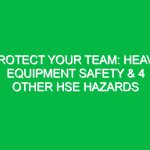In today’s fast-paced work environment, ensuring the health and safety of employees is more crucial than ever. Health and safety tips at work are essential strategies aimed at minimizing risks and creating a safer workplace. This article explores vital health and safety tips within the Health, Safety, and Environment (HSE) domain, providing practical insights that can be implemented in various organizational settings.
The Importance of Health and Safety in the Workplace
Health and safety tips at work are not just guidelines; they form the backbone of a thriving workplace culture. The significance of these tips extends beyond mere compliance with laws and regulations. They foster a work environment that values employee well-being, enhances productivity, and reduces the likelihood of accidents. A safe workplace leads to higher employee morale, lower absenteeism, and increased retention rates. Moreover, organizations that prioritize health and safety often see a positive impact on their reputation, making them more attractive to potential employees and clients.
Key Health and Safety Tips at Work
1. Conduct Regular Risk Assessments
One of the foundational health and safety tips at work is the regular assessment of potential risks. Identifying hazards is the first step towards mitigating them. Companies should conduct thorough assessments to evaluate physical, chemical, ergonomic, and biological risks. For instance, a manufacturing plant might discover that machinery poses a significant risk due to moving parts. By implementing safety guards and providing proper training, the risk can be significantly reduced.
2. Implement Comprehensive Training Programs
Training is a critical aspect of workplace safety. Employees should receive training that is tailored to their specific roles and risks they may encounter. For example, workers in a chemical plant should undergo training on handling hazardous materials and responding to spills. Additionally, regular refresher courses ensure that employees remain aware of safety protocols and best practices. A company that invests in training ultimately fosters a culture of safety, where employees feel empowered to voice concerns and contribute to a safer work environment.
3. Promote Ergonomic Practices
Ergonomics is a key consideration in health and safety tips at work, particularly for jobs that require repetitive motions or prolonged periods of sitting. Proper workstation setup is crucial in preventing musculoskeletal disorders. For example, an office worker should have their monitor at eye level and their chair adjusted to support their back. Implementing ergonomic assessments and providing ergonomic tools, such as adjustable chairs and keyboard trays, can significantly reduce the risk of injury and enhance employee comfort and productivity.
4. Maintain a Clean and Organized Workplace
A cluttered workplace can lead to accidents and injuries. Regular cleaning schedules and organizational practices should be enforced to maintain a tidy environment. For instance, ensuring that walkways are clear of obstacles and that spills are promptly cleaned can prevent slips and falls. Moreover, proper storage solutions for tools and materials can help create an organized workspace, reducing the likelihood of accidents. Employees should be encouraged to take part in maintaining cleanliness and organization, fostering a shared responsibility for safety.
5. Encourage Open Communication
Effective communication plays a vital role in workplace safety. Employers should establish channels where employees can report hazards or safety concerns without fear of reprisal. Regular safety meetings can serve as a platform for discussing potential issues and sharing experiences. For example, if a worker identifies a safety concern related to equipment malfunction, they should feel comfortable reporting it. Open communication not only helps in quickly addressing safety issues but also builds trust within the team.
6. Ensure Proper Use of Personal Protective Equipment (PPE)
Personal Protective Equipment (PPE) is essential in many workplaces, especially in industries with inherent risks. Employees must be trained on the proper use and maintenance of PPE. For instance, in a construction environment, hard hats, gloves, and safety goggles are necessary to protect against common hazards. Organizations should regularly inspect PPE to ensure it is in good condition and replace any damaged items promptly. A workplace that prioritizes PPE usage significantly reduces the risk of injuries and demonstrates a commitment to employee safety.
7. Implement Emergency Preparedness Plans
Being prepared for emergencies is a vital component of workplace safety. Organizations should develop comprehensive emergency response plans that address various potential scenarios, from fires to natural disasters. Conducting drill exercises helps employees become familiar with evacuation routes and emergency procedures. For example, a healthcare facility may conduct regular fire drills to ensure that staff knows how to respond quickly and safely. By having clear emergency protocols in place, organizations can safeguard their employees during critical situations.
8. Regularly Review and Update Safety Policies
Health and safety policies should not be static; they require regular reviews and updates to remain effective. As workplace conditions and regulations evolve, organizations must adapt their safety protocols accordingly. For instance, a company may need to revise its policies in response to new legislation regarding workplace safety. Regularly engaging employees in this review process can provide valuable insights and help identify areas for improvement. A proactive approach to safety ensures that organizations stay ahead of potential risks.
9. Foster a Culture of Safety
Creating a safety-oriented culture is perhaps one of the most impactful health and safety tips at work. This culture should be promoted at all levels of the organization, from management to entry-level employees. Leaders must model safe behaviors and prioritize employee safety in decision-making processes. Encouraging employees to take ownership of safety practices and recognize their peers for safe behaviors can reinforce this culture. For example, a monthly safety award for employees who demonstrate exceptional commitment to safety can motivate others to follow suit.
10. Utilize Technology for Safety Enhancements
Technology can play a significant role in improving workplace safety. From wearable safety devices that monitor worker health to software that tracks incidents and near misses, leveraging technology can enhance safety outcomes. For instance, construction companies often use drones to assess job sites for potential hazards without putting workers at risk. By embracing innovative solutions, organizations can stay ahead of risks and promote a safer work environment.
Regulations and Standards Governing Workplace Safety
Understanding the legal landscape surrounding workplace safety is essential for compliance and effective safety management. Several regulations govern health and safety tips at work across different regions. For instance, in the United States, the Occupational Safety and Health Administration (OSHA) sets and enforces standards to ensure safe working conditions. Similarly, the Health and Safety Executive (HSE) in the UK oversees workplace safety regulations. Organizations must familiarize themselves with these regulations to ensure compliance and reduce liability. Regular audits and inspections can help identify areas where safety practices may fall short of legal requirements.
Conclusion
Health and safety tips at work are vital for creating a secure and productive workplace. By implementing regular risk assessments, comprehensive training, ergonomic practices, and effective communication, organizations can significantly enhance employee safety. The importance of fostering a culture of safety cannot be overstated, as it lays the groundwork for a proactive approach to health and safety. Additionally, staying informed about regulations and continuously updating safety practices ensures that organizations remain compliant and protect their workforce.
Ultimately, prioritizing health and safety is not just a legal obligation; it is a fundamental responsibility that influences employee well-being, productivity, and organizational success. By taking proactive steps and integrating these essential health and safety tips into daily operations, employers can create a safer workplace where employees feel valued and protected.


